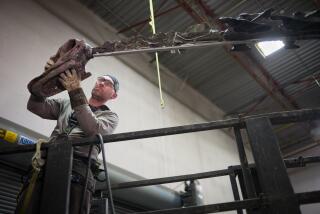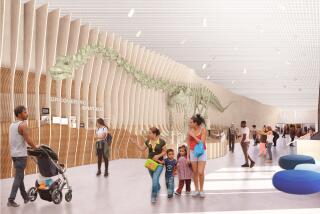Museum Plans Whale of a Renovation
- Share via
WASHINGTON — The biggest exhibit at the National Museum of Natural History has a problem: It’s a whale without a bellybutton.
A critique done for the museum says, “A blue whale’s umbilicus--roughly 8 inches across--is not a subtle feature and cannot be omitted from an accurate model.”
As part of a five-year, $26-million renovation, the museum plans to replace the 92-foot-long, 40-year-old model and change other exhibits as well, to bring them more up-to-date scientifically.
Officials also plan a new focus for the country’s largest collection of specimens, part of the Smithsonian Institution: exploring the connections among living creatures, inanimate things and the people who study them.
The new and slightly larger whale will go up in a hall devoted to mammals instead of the hall for sea creatures and will give visitors a better idea of how it actually lives.
“The first thing you want to tell about whales is that they’re mammals, not fish, so she’ll be nursing her calf,” said Robert Sullivan, the museum’s associate director for public programs.
The current whale model was based on 1950s science, when builders had less information about how an active whale looks. The original, in the British Museum, was modeled on a dead and bloated animal.
Labels in the museum, one of the most popular on the national Mall, have been continuously updated and consist largely of basic facts of science that don’t change much. But new information accumulates over the years, such as that about humans’ ancestors.
In the current exhibit on “The Human Family Tree,” officials have put up signs warning that some material is outdated:
“What’s new?” one label asks. “Recent evidence suggests Neanderthals lived in Europe, the Near East and Central Asia, not in Africa or East Asia, so this map is wrong.”
That didn’t faze Susan Bonjorno, who visited the museum Wednesday on her honeymoon.
“They’re constantly revamping what they think,” said Bonjorno, who teaches third grade in Paramount, Calif. “Every time somebody finds some little artifact, it changes what everybody thinks.”
The section will be replaced by a larger one using practical demonstrations to answer the question, “What does it mean to be human?” It also will show the differences between humans and even their most advanced relatives.
“A chimpanzee can touch his thumb with his forefinger, but he hasn’t got the precise grip that you need to drive a nail or thread a needle,” Sullivan said.
In another major operation, the museum will move the biggest stuffed elephant in captivity, known to the staff as Henry, about 6 feet from the center of the soaring rotunda where he now stands.
The move will weaken Henry’s imposing position as a symbol of the museum. But it will reinforce the renovation’s main theme, putting Henry in the environment he knew when alive, with an interactive display to help visitors learn about his world.
The renovation also includes brightening up the 1910 building by removing covers from its extensive skylights and removing many interior walls put up decades ago when the building was used for government offices.
“What’s better for natural history than natural light?” Sullivan asked.
The renovations are made possible by a $20-million gift, the largest in the Smithsonian’s history, from Kenneth Behring, a real estate developer who formerly owned the Seattle Seahawks.
Museum officials also hope to broaden their audience. Three years ago, few people beyond the 17,000 who visit on an average day could learn much from the museum, but now it can take as many as 65,000 students at a time on “electronic field trips” via the Internet.
When the renovation is complete in 2003, it will be possible for anyone to take a museum “virtual tour” by computer.
On Wednesday, 2-year-old Lindsey Concepcion of Minneapolis was seeing the sites the old-fashioned way--in person. She didn’t much like the whale, but that may have been because her father threatened jokingly to feed her to it.
She did love the dinosaurs, said her mother, Jeannette. No changes are being made to the dinosaur exhibit.
More to Read
Sign up for Essential California
The most important California stories and recommendations in your inbox every morning.
You may occasionally receive promotional content from the Los Angeles Times.













